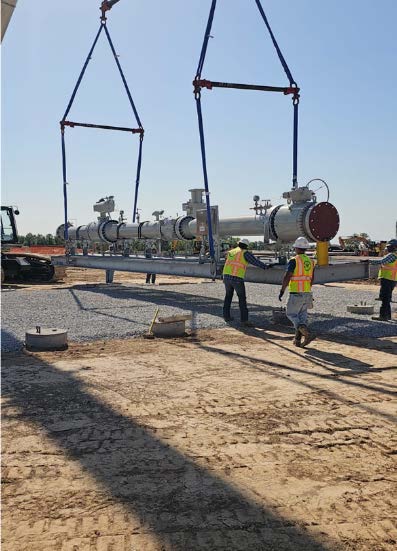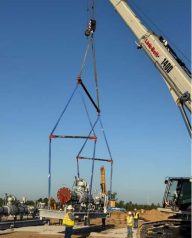Lifting and Rigging Safety:
“Inspect before you connect.”
 |
 |
 |
Annually about 50 riggers are killed when loads have slipped from the rigging or when the rigging has failed.
Some Dos and Don’ts to Remember:
- Name one member of the crew to act as the signal person and instruct the equipment operator to recognize signals from that person only;
Rigger must be sure they are in the clear before giving an “all ready” to the signal person. When you have positioned the sling or choker you’re using, release it, if possible, before you give the “all ready” signal; - If you must hold it in position, be sure your hand is clear of pinch points. In fact, your hand should be far enough away so there’s no possibility of a frayed wire catching your glove and jerking your hand into a pinch point;
- Watch out for the roll or swing of the load. Since it’s almost impossible to position the hook exactly over the load center, there will just about always be a swing or roll. Anticipate the direction of the swing or roll and work away from it;
- Never place yourself between material, equipment, or other stationary objects and the load. Also, stay away from stacked material that may be knocked over by a swinging load;
- Never stand under the load. Keep from under the boom as much as possible. Chances are that nothing will break, but something might;
- Look over the place where the load is to be set. Remove unnecessary blocks or other objects that might fly up if struck by the load; and
- When lowering or setting the load, be sure your feet and all other parts of your body are out from under it. Set the load down easily and slowly so that if it rolls on the blocking, it will be a slow shift that you can get away from.
Safety Statement
Bluewater’s safety vision is to have all employees and subcontractors at every level demonstrate a personal commitment to continuous safety improvement.
Corporate Commitment
Bluewater Constructors’ management is firmly committed to a culture where safety is priority and all facilities and projects are operated in a safe, efficient manner and in compliance with applicable safety, health and environmental regulations
Bluewater’s workforce is its greatest asset. Therefore we set our employees up to succeed by providing them with the training necessary to safely complete their tasks. Every job begins the day with a morning safety meeting. A JSA (Job Safety Analysis) is completed for each task that is to be performed for the day, with involvement from each employee.
Onsite Safety Measures
- Assigned Safety Personnel
- Qualification/Competency Training
- New Employee Safety/Environmental Orientation
- Daily Pre-Work Safety Meeting
- Job Daily Safety Audits
- Activity Risk Assessments
- Employee Stop Work Authorization
- Behavioral Based Safety Observation
Safety Incentives
The S.T.A.R. Card (Safety Task Awareness Report) initiative aims to promote a culture of safety among BWC employees. We encourage active participation in the following ways:
- Stay Safe, Get Rewarded: Employees are incentivized to engage in safe practices.
- Weekly Drawings: Participants will be entered into weekly drawings as a reward for their efforts. The winner from each weekly drawings will be entered into the monthly drawing!
- Monthly Drawings: Winners from the weekly drawings will automatically be entered into the monthly drawing.
- Share Safety Observations: Employees are encouraged to report safety observations and contribute to overall workplace safety.
- Be Proactive: Engage in proactive safety measures to prevent incidents before they occur.
- Collective Responsibility: Strengthening our commitment to safety requires a collective effort. Everyone plays a crucial role.
- Make Your Voice Heard: Your input is invaluable in shaping a safe work environment
 713-462-8525
713-462-8525 

